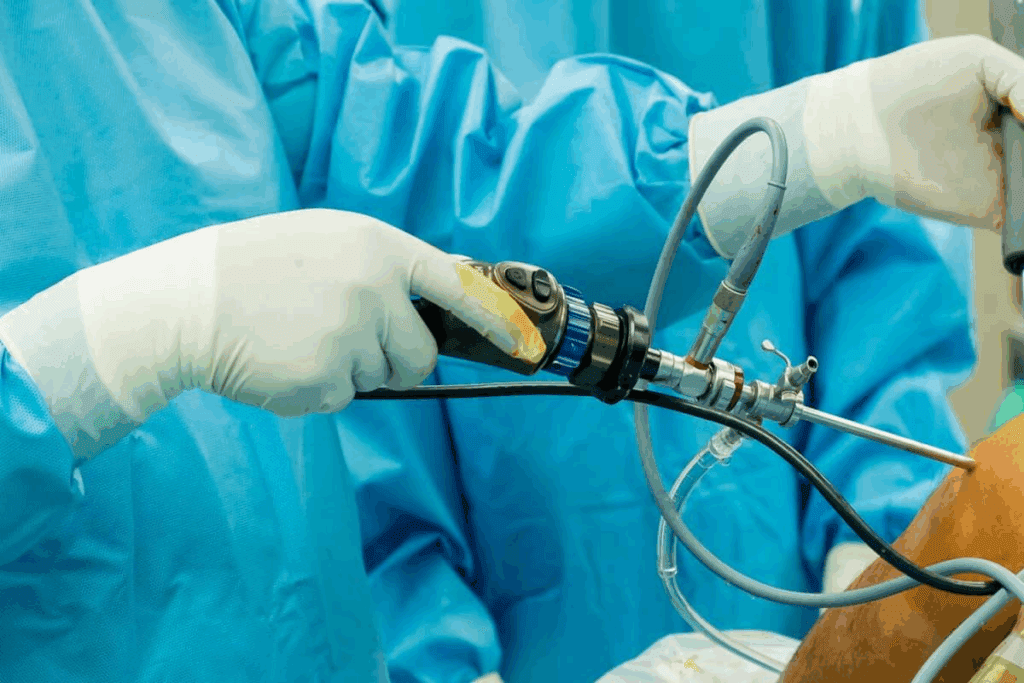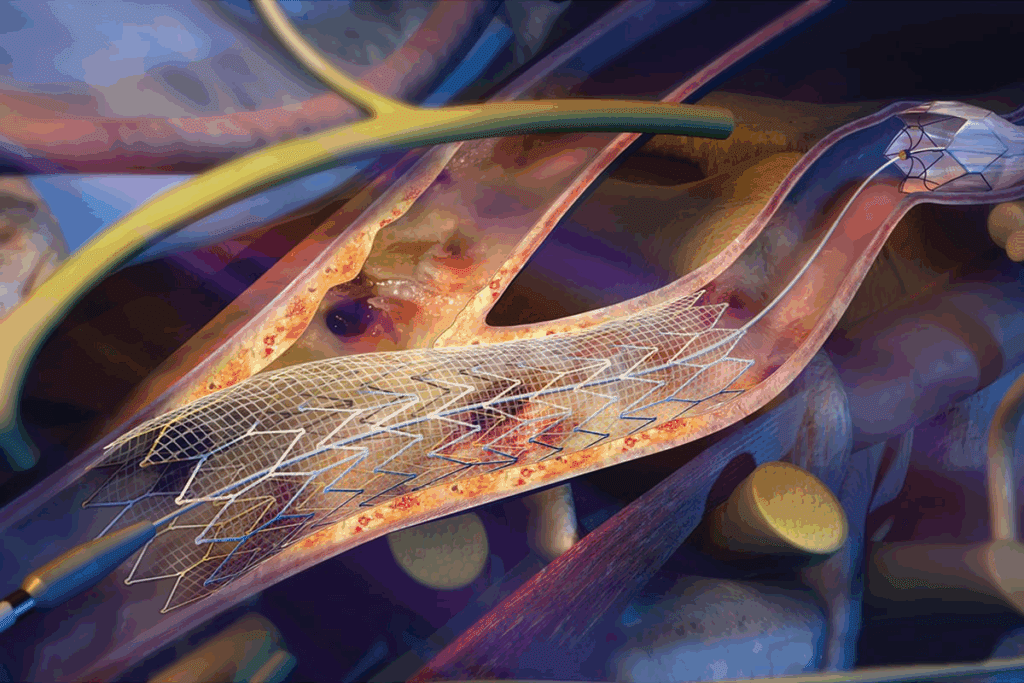Last Updated on November 26, 2025 by Bilal Hasdemir

Many patients ask, how serious is a carotid artery surgery and what it involves. Carotid artery surgery, including carotid endarterectomy and carotid artery stenting (CAS surgery), is an important procedure designed to lower the risk of stroke in people with severe carotid artery stenosis.
It’s natural to wonder how serious is a carotid artery surgery, especially when thinking about undergoing it. Like all major procedures, it carries certain risks, but it also offers life-saving benefits. Carotid endarterectomy removes plaque buildup that narrows the arteries, improving blood flow to the brain and helping prevent strokes.
Understanding how serious is a carotid artery surgery means learning about both its potential complications and the safety measures taken by experts. At Liv Hospital, patient care and safety are top priorities. Their highly skilled surgical team follows strict protocols to minimize risk and ensure successful outcomes.
By being informed about how serious is a carotid artery surgery, patients can make confident decisions and feel more at ease about their treatment and recovery process.
Key Takeaways
- Carotid artery surgery is a critical procedure to prevent stroke.
- Carotid endarterectomy and carotid artery stenting are the primary surgical options.
- Understanding the risks and benefits can help alleviate patient concerns.
- Modern safety protocols and patient-centered care improve surgical outcomes.
- Carotid artery surgery risks can be minimized with proper care and precautions.
Understanding Carotid Artery Surgery

Carotid artery surgery is a life-saving option for many. It’s designed to fix blockages in the carotid arteries. These arteries are key to getting oxygen to the brain.
The carotid arteries are in the neck and are vital for brain health. If they get blocked by plaque, the risk of stroke goes up. Surgery can help lower this risk.
What Is Carotid Artery Surgery?
Carotid artery surgery aims to improve blood flow through these arteries. Carotid endarterectomy is a common method. It removes plaque from the artery. This can be done under local or general anesthesia, depending on the situation.
The main goal is to prevent stroke by ensuring the brain gets enough oxygen. By removing blockages, these surgeries keep the arteries open.
Types of Carotid Artery Procedures
There are two main types of carotid artery procedures: Carotid Endarterectomy (CEA) and Carotid Artery Stenting (CAS). CEA removes plaque surgically. CAS is less invasive, using a stent to keep the artery open.
- Carotid Endarterectomy (CEA): A surgical procedure to remove plaque buildup.
- Carotid Artery Stenting (CAS): A minimally invasive procedure involving the placement of a stent.
Both procedures are chosen based on the patient’s condition and history. Knowing about these options helps in making informed decisions about care.
The Anatomy of Carotid Arteries

It’s key to know about the carotid arteries to understand carotid artery surgery. These arteries in the neck are vital. They carry blood to the brain.
Location of Arteries in Neck
The carotid arteries sit on both sides of the neck. They start from the aortic arch in the chest. Then, they go up the neck, splitting into internal and external branches.
The internal carotid artery sends blood straight to the brain. The external carotid artery goes to the face and neck.
How Many Arteries Are in the Neck?
In the neck, you’ll find four main arteries. There are two carotid arteries and two vertebral arteries. The carotid arteries are key in carotid artery surgery. They supply a lot of blood to the brain.
Does the Carotid Artery Go to the Brain?
Yes, the carotid artery does go to the brain. The internal carotid artery branch carries oxygenated blood to it. Any blockage can cause serious problems, like a stroke.
Knowing this anatomy is vital. It shows why carotid artery surgery is sometimes needed.
Why Carotid Artery Surgery Is Performed
Carotid artery surgery is a key treatment for those with severe carotid artery stenosis. This condition can cause a severe stroke if not treated. The surgery aims to fix the problems caused by stenosis and prevent strokes.
Carotid Artery Stenosis and Its Dangers
Carotid artery stenosis happens when the main blood vessels to the brain narrow due to plaque. This narrowing can cut down blood flow to the brain, leading to a stroke. The risks of carotid artery stenosis are high, as it can cause severe disability or even death.
The dangers of carotid artery stenosis are many. They include stroke, transient ischemic attacks (TIAs or “mini-strokes”), and other heart problems. Knowing these risks helps us choose the best treatment.
“The presence of carotid stenosis is a marker of systemic atherosclerosis, and these patients are at increased risk of cardiovascular events.”
Experts stress.
When Does Carotid Stenosis Require Surgery?
Deciding on surgery for carotid stenosis depends on the stenosis’s severity and the patient’s health. We usually suggest surgery for those with stenosis over 70%, and more so if they show symptoms.
| Degree of Stenosis | Symptoms | Recommended Treatment |
| <50% | Asymptomatic or Symptomatic | Medical Management |
| 50-69% | Symptomatic | Surgery or Medical Management |
| >70% | Symptomatic or Asymptomatic | Surgery |
Patient Selection Criteria
Choosing the right patients for carotid artery surgery involves looking at several factors. These include the stenosis’s degree, symptoms, and overall health. We also consider the patient’s medical history, lifestyle, and preferences.
The criteria help ensure that surgery benefits the patient while keeping risks low. This personalized approach improves surgery outcomes for patients.
Preventing Stroke: The Primary Goal
The main goal of carotid artery surgery is to prevent stroke by improving blood flow to the brain. By removing plaque, we can greatly lower stroke risk and enhance the patient’s quality of life.
Preventing stroke is a complex task. It involves surgery, lifestyle changes, and medical care. We work with our patients to create a treatment plan that meets their needs.
The Carotid Endarterectomy Procedure Explained
Carotid endarterectomy is a surgery to remove plaque from the carotid arteries. This helps restore blood flow to the brain. It’s key for those with severe carotid artery stenosis, as it lowers stroke risk.
Removal of Inner Lining of Artery: The Process
The surgeon makes a neck incision to reach the carotid artery during the surgery. The patient is under anesthesia for comfort. The artery is then opened, and the plaque and inner lining are removed.
This process is done carefully to clean the artery fully. After removing the plaque, the artery is stitched back. This improves blood flow by restoring the artery’s normal size.
Cleaning Out the Carotid Artery
Removing plaque from the carotid artery is a key part of the surgery. Plaque buildup narrows the artery, reducing brain blood flow. Removing it lowers stroke risk.
Right CEA vs. Left CEA Considerations
Whether it’s a right or left carotid endarterectomy depends on the affected artery. Both procedures are similar but can vary based on anatomy and surgeon preference.
Both sides have similar risks and benefits. The choice is based on imaging that shows stenosis levels on each side.
| Considerations | Right CEA | Left CEA |
| Anatomical Approach | Similar to left CEA, with variations based on patient anatomy | Standard procedure with adjustments for patient-specific factors |
| Risks | Comparable to left CEA, including stroke, bleeding, and nerve injury | Similar to right CEA, with risks including stroke, bleeding, and nerve damage |
| Benefits | Reduces stroke risk by removing plaque | Improves blood flow by clearing plaque buildup |
Pictures of Carotid Artery Surgery: What to Expect
Actual surgical images can be graphic. But understanding the procedure helps patients prepare. The surgery involves a neck incision, dissecting the artery, and removing plaque.
Visual aids like diagrams or videos can help. They provide a clearer view of the steps in carotid endarterectomy. This helps patients and their families understand the procedure and recovery.
Carotid Artery Stenting: An Alternative Approach
Carotid artery stenting (CAS) is a new way to treat carotid artery stenosis. It’s less invasive than traditional surgery. CAS uses a stent to keep the artery open and improve blood flow to the brain.
The CAS Surgery Procedure
The CAS procedure is done under local anesthesia. The patient stays awake. A catheter is guided through the femoral artery to the carotid artery, where a filter catches debris.
The stent is then placed across the narrowed segment. Balloon angioplasty may be used to ensure the stent is fully expanded. This method is less risky than open surgery.
Comparing CAS to Endarterectomy
CAS and carotid endarterectomy (CEA) are both effective for treating carotid artery stenosis. CEA involves surgically removing plaque from the carotid artery. CAS uses a stent to keep the artery open.
“The choice between CAS and CEA depends on various factors, including the patient’s overall health, the severity of stenosis, and the presence of other medical conditions.”
A leading vascular surgeon
Who Is a Better Candidate for Stenting vs. Endarterectomy
Choosing between CAS and CEA depends on several factors. Patients with certain anatomical features or comorbidities may be better suited for CAS. This is because CAS avoids the risks of open surgery.
- Patients with high-risk anatomical features for surgery
- Those with significant comorbidities that increase surgical risk
- Patients who have had previous neck surgery or radiation
The decision between CAS and CEA should be made for each patient individually. It depends on their specific needs and preferences.
How Serious Is a Carotid Artery Surgery?
Carotid artery surgery is serious but has a high success rate in preventing strokes. It’s important to consider the risks and benefits. This surgery is a big step, but it can save lives.
The seriousness of carotid artery surgery depends on its safety, success rates, and recovery. Knowing these details helps patients understand the surgery’s effectiveness in preventing strokes.
Overall Safety Profile
The safety of carotid artery surgery is a big concern. Studies show it’s safe when done by experienced surgeons. Choosing a skilled team is key to reducing risks.
Important safety points include:
- Low mortality rates: The risk of death from the surgery is very low.
- Stroke prevention: The surgery is very effective in preventing strokes.
- Minimally invasive techniques: New techniques make the surgery less invasive, leading to quicker recovery.
Success Rates and Effectiveness
Carotid endarterectomy is very successful in preventing strokes. Studies show it lowers stroke risk in selected patients. It’s a proven method for those with severe stenosis.
Success statistics are impressive:
- It significantly reduces stroke risk in patients with severe stenosis.
- Arteries stay open after surgery, showing high patency rates.
- Restenosis rates are low, meaning arteries don’t narrow again.
Recovery Timeline and Process
Most people can get back to normal in one or two weeks after surgery. The recovery is usually smooth, with some discomfort or numbness at the site.
Recovery highlights include:
- Hospital stay: Usually just one night.
- Activity restrictions: Avoid heavy lifting and strenuous activities for a few weeks.
- Follow-up care: Regular check-ups are important to monitor healing and watch for complications.
Understanding the safety, success, and recovery helps patients decide on carotid artery surgery.
Risks and Complications of Carotid Surgery
It’s important to know the risks of carotid artery surgery. This surgery aims to prevent stroke but has its own complications.
Immediate Surgical Risks
Carotid surgery, like any big operation, has risks right away. These can happen during or soon after the surgery. Some of these risks include:
- Stroke or Transient Ischemic Attack (TIA): A big risk is having a stroke or TIA during or after surgery.
- Heart Attack: Surgery can stress the heart, leading to a heart attack in some patients.
- Cranial Nerve Injury: Damage to nerves around the carotid arteries can cause symptoms like trouble swallowing or changes in voice.
- Wound Hematoma: Bleeding at the surgery site can cause a hematoma, needing extra treatment.
- Infection: As with any surgery, there’s a chance of infection at the site.
These risks show why choosing the right patient and using careful surgical techniques are key.
Long-term Carotid Surgery Complications
There are also long-term effects to think about after carotid surgery.
| Complication | Description | Management |
| Restenosis | Narrowing of the artery again after surgery | Monitoring with ultrasound, possible repeat surgery or angioplasty |
| Nerve Damage | Permanent damage to nerves around the carotid artery | Speech therapy, swallowing therapy, or other supportive measures |
| Chronic Pain | Long-term pain at the surgery site | Pain management strategies, possibly including medication or physical therapy |
Knowing about these long-term complications helps patients understand their recovery and ongoing health better.
Talking to a healthcare provider about these risks and complications is vital. It helps understand how they might affect you personally.
Is Carotid Artery Surgery Dangerous?
It’s important to know the risks of carotid artery surgery before deciding. This surgery can save lives, but it also comes with risks. These risks need to be carefully thought about.
Mortality Rates Associated with Carotid Surgery
The death rates from carotid endarterectomy, a common surgery, are usually low. But they can change based on the patient. Studies show that the risk of stroke or death is less than 3% for patients without symptoms. It’s a bit higher for those with symptoms.
Older adults and those with chronic conditions face higher risks. For example, heart disease, diabetes, or high blood pressure can increase the danger during and after surgery.
Carotid Surgery Risk Factors
Several factors can affect the success of carotid artery surgery. These include:
- Age: Older patients tend to have higher risks.
- Pre-existing medical conditions: Conditions like heart disease, diabetes, and hypertension.
- Severity of carotid stenosis: Higher degrees of stenosis may increase surgical risks.
- Symptomatic vs. asymptomatic: Patients with symptoms like transient ischemic attacks (TIAs) or strokes may have different risk profiles.
Balancing Surgical Risks Against Stroke Prevention Benefits
When thinking about carotid artery surgery, weighing the risks against the benefits is key. For many, the benefits of preventing strokes are worth the risks. This is true, even more so for those at high risk for stroke.
The data show that the risk of stroke or death from carotid endarterectomy is usually low. So, for those with severe carotid stenosis, surgery can be a good option to prevent strokes.
| Risk Factor | Impact on Surgery |
| Age | Increased risk for older adults |
| Pre-existing Conditions | Higher risk for patients with heart disease, diabetes, etc. |
| Severity of Stenosis | Higher stenosis degrees may increase risks |
Understanding these factors and talking to healthcare providers can help patients make informed choices. This way, they can decide if carotid artery surgery is right for them.
Post-Operative Care and Recovery
The time after carotid artery surgery is key to a good outcome. We’ll guide you through this period. It’s important to know what helps in a smooth recovery.
Duration of Hospital Stay
Patients usually stay overnight in the hospital after surgery. This lets doctors watch for any quick problems. How long you stay can depend on your health and any other conditions you have.
| Procedure | Typical Hospital Stay | Monitoring Purpose |
| Carotid Endarterectomy | Overnight | Monitoring for immediate complications |
| Carotid Artery Stenting | Variable, often shorter than CEA | Observation for possible vascular reactions |
Activity Restrictions After Surgery
After surgery, you’ll need to follow some rules to avoid problems and help your body heal. You should avoid heavy lifting, bending, or hard work for a few weeks. Slowly start doing normal things again, as your doctor advises.
“Patients should avoid driving for at least 24 hours after carotid artery surgery, and longer if they are taking narcotic pain medication.”
As advised by professionals
Follow-up Care and Monitoring
Follow-up care is very important for recovery. You’ll have check-ups to see how you’re healing, watch for any issues, and manage your meds. It’s key to keep these appointments to recover well.
- Follow-up appointments are usually a few weeks after surgery.
- They include checking the surgery site and your brain function.
- Your meds will be adjusted as needed.
Signs of Complications to Watch For
It’s important to know the signs of possible problems after surgery. Look out for severe headaches, trouble speaking, sudden weakness, or vision changes. If you notice any, get medical help right away.
Following post-operative care instructions can greatly help your recovery after carotid artery surgery. Our team is here to support you every step of the way.
Conclusion: Making Informed Decisions About Carotid Surgery
Understanding carotid artery surgery is key for patients. We’ve looked at its risks, benefits, and recovery. This includes the different procedures like carotid endarterectomy and stenting.
Knowing about carotid surgery helps patients make better choices. We’ve talked about who should get surgery, its safety, and how long it takes to recover. This way, patients can decide what’s best for them.
The main aim of carotid surgery is to stop strokes and help patients get better. We want to help patients understand their options. We encourage them to talk to their doctors to make the best decisions for their health.
FAQ
What is carotid artery surgery?
Carotid artery surgery, also known as carotid endarterectomy, is a procedure. It removes plaque buildup from the carotid arteries in the neck. These arteries supply blood to the brain. The surgery helps prevent stroke by improving blood flow.
Is carotid artery surgery dangerous?
Like any surgery, carotid artery surgery carries risks. But it is generally safe when done by experienced surgeons. Risks include stroke, heart attack, and death, but these are rare.
What are the risks of carotid endarterectomy?
Risks include stroke, heart attack, nerve damage, and bleeding. But the risk of serious complications is low. The procedure is effective in preventing stroke.
When does carotid stenosis require surgery?
Surgery is recommended for severe (70% or more) and symptomatic carotid stenosis. It’s also considered for some asymptomatic severe stenosis. The decision depends on stenosis degree and overall health.
What is the difference between carotid endarterectomy and carotid artery stenting?
Carotid endarterectomy removes plaque from the artery. Carotid artery stenting places a stent to keep the artery open. Both aim to improve blood flow and prevent stroke, but are used based on patient-specific factors.
How many arteries are in the neck?
There are two main carotid arteries in the neck. One on each side supplies blood to the brain. Each carotid artery branches into the internal and external carotid arteries.
Does the carotid artery go to the brain?
Yes, the internal carotid artery supplies blood directly to the brain. It plays a critical role in brain function. The carotid arteries are essential for delivering oxygenated blood to the brain.
What is the recovery process like after carotid artery surgery?
After surgery, patients stay in the hospital for a short time. They may feel discomfort, swelling, or bruising in the neck. Activity restrictions are advised, and follow-up care is needed to monitor recovery and watch for complications.
What are the signs of complications after carotid artery surgery?
Signs of complications include severe headache, difficulty speaking or swallowing, and weakness or numbness in the face or limbs. Severe pain or swelling in the neck is also a sign. Patients should seek immediate medical attention if they experience any of these symptoms.
How effective is carotid artery surgery in preventing stroke?
Carotid artery surgery is highly effective in preventing stroke in patients with significant carotid stenosis. By removing plaque or keeping the artery open with a stent, these procedures significantly reduce the risk of stroke.
References
- Saha, S. P., Greenberg, R. K., & Ercole, A. (2015). Carotid endarterectomy: current concepts and practice. Archives of Vascular Medicine & Surgery, (5), article XXX. https://www.ncbi.nlm.nih.gov/pmc/articles/PMC4572020/






